With the end of another year, I like to review the markets and my trades. 2011 marked my 37th year of investing in stocks.
In early January I indicated that my strategy would be the cautious bull as I felt that the easy money had been made in the market since the recovery from the March 2009 lows. The cautious bull strategy has served me well in many bear markets. 2011 for many investors was not a great year for returns. I have received a lot of emails this past week and many investors lost money in 2011, particularly with the pullback in August.
This is indeed a shame as after July, put selling and my spy put hedge provided excellent returns. Once the market corrected in August Volatility climbed dramatically and this pushed up option premiums, primarily on the put side.
Covered Calls And Naked Puts Are Not Equal
There is a belief among many investors that covered calls and naked puts (or cash secured puts as many refer to them), are equal. They are NOT. This debate has raged for years but this year again put premiums far outstripped call premiums, just as they did in 2007, 2008, 2009 and 2010. In any market with a bit of volatility, put premiums are higher than call premiums and this has been the case for decades.
Below is the VIX Chart for the past 5 years showing the volatility. This year the VIX reached a high of 48 which is the same high as the previous year. It is this volatility that brings in excellent profits by pushing up put premiums on stocks.
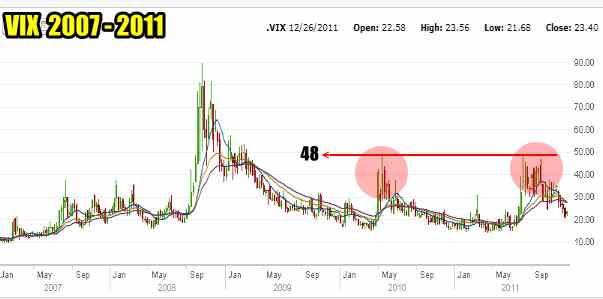
VIX Index showing Volatility from 2007 to 2011
PUT SELLERS NEED TO UNDERSTAND THE VIX
It is important for put sellers to realize that when the VIX climbs indicating that stocks are coming under selling pressure, it marks an excellent opportunity to sell puts on their favorite stocks at prices they are comfortable to own the stocks at.
HOWEVER:
When a stock is under pressure, and a put is sold that was out of the money and then suddenly becomes in the money, the put seller should not panic and close for losses. Instead consider that volatility as it climbs OR falls will continue to benefit the put seller’s position. Also consider why you sold the put in the first place. Consider the stock or index fund and the strike you selected. Recall past markets and study charts to see how often the stock has recovered past your sold put strike. Stay positive and have in place a rescue strategy.
PUTS ARE RARE ASSIGNED EARLY
When puts are sold, it is rare for the underlying shares to be assigned (or put to them – hence the term put selling), before expiration. Even in the bear market of 2008 – 09, I had puts that fell deep in the money and yet NONE were assigned before expiration.
CONSIDER THIS MICROSOFT STOCK PUT TRADE
Consider this Microsoft Stock put trade during November 2008 to April 2009. In the first chart I have marked where I sold the $20.00 puts and then rolled them when the stock bounced up. Finally in Feb when I bought to close and rolled into March, Microsoft stock plummeted to $14.87 on March 6 2009 marking a 25.65 percent decline from my sold put at $20.00.

Microsoft Stock - 2008 to 2009 Collapse
The Microsoft stock put trade chart 2 (below) shows the recovery period in the stock after the final plunge in March 2009. I bought back my March $20 puts for $3.75 and sold in Apr again at $20 for $3.98.
Eventually I ended up in May and when the options expired on May 15 they closed at $20.22. I did not want the chance of having the shares assigned as my plan was to sell puts. Therefore I bought back the puts during the day and promptly sold puts into June 2009 again at the $20.00 strike.
If you look at the Microsoft trades in these two charts you can see that I bought back my spy puts when Microsoft stock rose and then took advantage of the high volatility and sold further out in time to earn more premium. I did not wait to see if the stock would fall back which would have earned me much higher put premiums. In a market panic such as the period below, an investor will never know what the stock could do. I have always found it best to buy to close and sell to open at the same time in market panics.

Microsoft Stock Put Trades During 2009 Recovery From March
WHAT TO TAKE AWAY FROM THE MICROSOFT STOCK EXAMPLE
This trade is typical of many trades I do on favorite stocks. I am showing this trade to show that not once during the trade were shares put to me, despite at one point the stock being down over 25% from my deep in the money put. I show this trade to inform investors the value of selling against large cap, strong stocks that have moats of money, strong balance sheets, good management and solid earnings. Every single stock I sold puts against in the 2008 to 2009 bear collapse recovered.
Therefore when selling puts turn off your television and tune out all the doom and gloom articles and concentrate on fundamentals.Recall that if the world should end and economic calamity takes down the entire world, it is not going to matter if you are holding stocks, bonds, gold, silver or cash. Everything will be hurt.
Big Players Cannot Play In The Small Investor’s World
As a small investor I have significant advantages over big players with hundreds of millions or billions of capital. I can sell options, buy options, do spreads and hedge with my spy put strategy. My SPY PUT hedge in itself is impossible for a big player to trade. Take advantage of the small investor world and outplay the big players. Stop being the small investor who buys stock or sells put options at the top of a stock’s range.
Hedge Funds Lost Money
2011 marked a year when many hedge funds again lost money. In a recent article I read on seeking alpha, hedge fund managers complained that the second half of the year was “brutal” for whipsaws and they took large losses. A number of hedge funds closed again this year.
As a small investor I don’t have their problems. I use technicals to steer me through every market and I stay with a handful of large cap stocks and play my little game of small gains.
While hedge funds got whipsawed with all the market gyrations, I enjoyed significant profits through put selling and earned excellent put premiums thanks to all the whipsaws that drove volatility high. But my kinds of profits do not interest hedge fund managers as the returns are far too small.
Where My Profits Came From In 2011
The most telling part of 2011 was the use of the cautious bull strategy to sell out of the money puts and close early, often for pennies and not wait for options expiry. After buying to close put options early, this freed up my capital, allowing me to put it back to work in another trade. Many times I was able to double dip in the same month. Therefore while often the trade only netted half a percent, the next trade may also net half a percent which in the end provided a full percentage for that month. Other months I managed 1.25% while remaining cautious.
As well, by selling a variety of puts on the same stock on dips, often selling one month out and then shortly afterwards selling two months out but at lower strikes, I was able to earn a decent return for the year and remain out of the money and had no shares assigned.
Finally, once the markets stalled in April it was obvious to me that the most important aspect for the rest of the year was to earn income but forget about the return and instead concentrate on earning income, any income.
To do this I stayed with my large cap stocks but picked the stronger less volatile stocks for smaller positions as they generated less income, such as Johnson and Johnson, Kraft and Clorox, and then put more capital to work in stocks like VISA, Microsoft and Exxon which have continued with higher volatility and therefore better percentage returns.
By keeping more capital at work in the higher volatility stocks, I was able to stay further out with my puts, yet earn a reasonable return. For example, if you look at the VISA Stock trades for the end of this year you can see that as of Dec 30 2011 I have over $190,000 tied into my VISA stock (V Stock) put trades or about 26% of my entire capital available. At the same time I had at the end of Dec 2011, just $33,000 tied to Kraft Foods (KFT Stock) or only about 5% of my available capital as Kraft Foods rarely had high put premiums as the stock has been in a slow climb most of the year keeping put premiums small.
Through combining the low volatility stocks with the higher ones, I was able to generate slightly more than 1% a month in returns.
At the end of the year I have ended up with no stock as I was exercised from my Nucor stock on the 28th of December as it was taken, to gain the dividend which was issued on Dec 28.
Interesting Trades For 2011
While I enjoyed all my trades this year, four trades stood out as the most interesting.
Microsoft Stock MSFT Stock – 2011 Annualized Return 38.68%
At the end of 2009 I had sold MSFT stock puts at the $30 strike and over the course of 2010 and into 2011 I have worked them down to Jan 2012 $26 strike. It is a great example of how puts are rarely assigned early even when in the money and of rolling lower and reducing the number of contracts at risk of assignment with each roll lower all the while earning more premium. I sold a lot of puts in Microsoft throughout 2011 which at the end of the year created an annualized gain of 38.68%. Microsoft has been a solid performer for 10 years now. You may want to view this article on Microsoft Stock The Ultimate Utility Stock and this one on Microsoft Stock Is Better The Gold.
Coca Cola Stock KO Stock – 2011 Annualized Return 24.61%
In November 2010 I sold leap puts at the $55 strike for a 5% return. Those leaps will expire in January of this year. In November 2011 I again sold leap puts at the $55 strike for 5.8% return. I suppose for a conservative investor, they could easily consider leap puts that are out of the money and earning between 4 and 5 percent. In the long run this could be a better investment than Treasuries or even bonds.
KO Stock has been in a long-term uptrend since the March 2009 stock market crash. It was a great stock with easy put selling opportunities all year-long.
Clorox Stock CLX Stock – 2011 Annualized Return 20.3%
Clorox stock had a wild time this year thanks to Carl Ichan who took a stab at convincing the board of directors to sell Clorox. Indeed in size, Clorox could easily be swallowed up by companies such as Procter and Gamble. His move pushed the stock to new all time highs above $75.00. For the first time I sold puts in over-value territory on the stock and I bought calls in August and sold them later in the month for 3 times what I paid. It was a terrific year and I ended it by selling the $62.50 puts into January.
VISA Stock V Stock – 2011 Annualized Return 34.89%
When Visa Stock was first issued in 2007 I felt confident it would double in value. This year it came close as it topped $100.00. Visa Stock and XOM Stock were two favorites of mine this year. The volatility in both stocks made for excellent put selling premiums and allowed me to earn terrific returns for the year. As well, in August 1000 shares were assigned at $82.50 which I sold a few trading sessions later at $87.50 for a 6% gain. At the end of 2011 I had 26% of my entire portfolio committed to put positions in V Stock. This is the first time since 2003 that I have so much capital tied into one stock.
Nucor Stock NUE Stock – 2011 Annualized Return 21.08%
Nucor Stock had a tough time this year but I had a lot of fun with NUE. On June 9 with the stock at $39.55 I sold the Oct $41 put for an incredible $3.91. I was sure NUE would end up by October higher than $41. I was wrong and on August 31 with the stock down to $36.50 I bought back the puts at $5.05 for a loss of $1.14. I then turned around and sold the Jan 2012 $35 put for $4.30 to win back my loss and earn a whopping $3.16 after covering the loss. With just a few more weeks to Jan expiry the stock is holding above my put strike. I have my fingers crossed.
Meanwhile on Aug 17 I had 500 shares at $37.00 assigned. Within days I had received more than 500 emails wondering why I had accepted shares and then sold the deep in the money $33 covered call to get exercised back out. In the end it all worked out and I made a small profit on this covered call trade and earned one dividend. On Dec 28 the shares were exercised and I didn’t earn the second dividend payment which was on Dec 28. The $33 covered call did not have enough premium to cover the dividend payment so it was exercised from me.
The Indexes For 2011
To end my 2011 review let’s see how the indexes ended the year.
The S&P 500 almost ended up where it had started! A true sideways year for the S&P which had been my prediction back in early January 2011 when I turned to the cautious bull strategy. At that time I felt the easy money had been made from the March 2009 crash to Dec 31 2010.
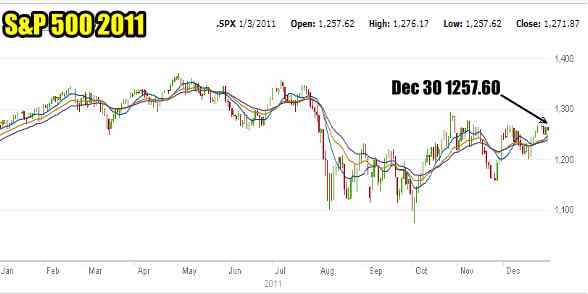
The NASDAQ also ended up pretty well where it started the year.
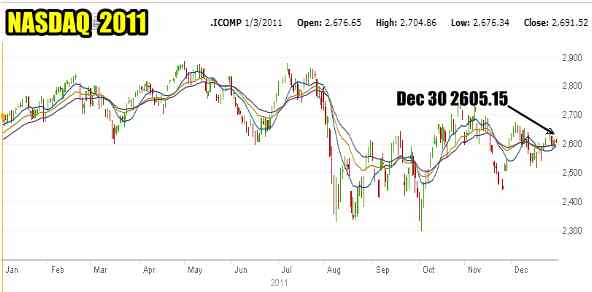
The Dow Jones on the other hand ended up with a 640 point gain or about 5.5% as smart money poured into large cap, blue chips.
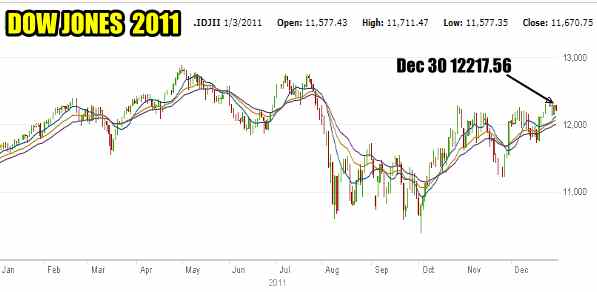
In Toronto, the TSX ended with an 11.6% decline, but while the index was down 11.6% many commodity stocks were down a lot more as the commodity trade get hammered in the fall. Stocks such as Talisman (TLM Stock) fell 50% from their Spring highs.
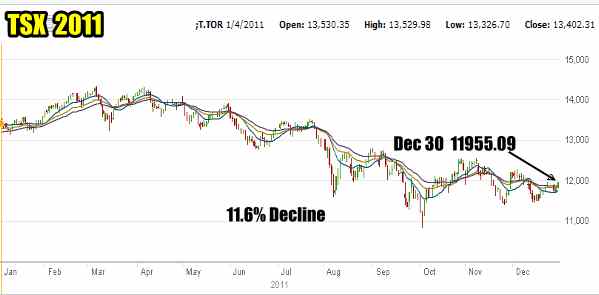
2011 Review Conclusion
While I realize many investors do not believe in technical analysis, it is obvious to me, year after year that technical analysis works wonders for my portfolios. I believe that most investors fail with technical tools because they do not use them consistently every single day. While investors blame technical analysis, usually they have not used the tools consistently and properly.
Another problem I noticed throughout the year from readers’ emails was the lack of having a plan. Planning is a top priority if an investor wants to be successful year after year.
My last comment for 2011, is about investors closing put options that were once out of the money and suddenly became in the money. Many investors closed what they felt were losing positions because they had sold puts either at the money or to close to the money, in what is obviously a bear market. In a bear market investors need to learn to spend less time worrying about earning monthly big gains and instead concentrate on selling far out of the money puts against quality large caps that even if they pay half a percent or even less, are still adding profit to their portfolios. The overall goal is earning capital while preserving what you have already made.

